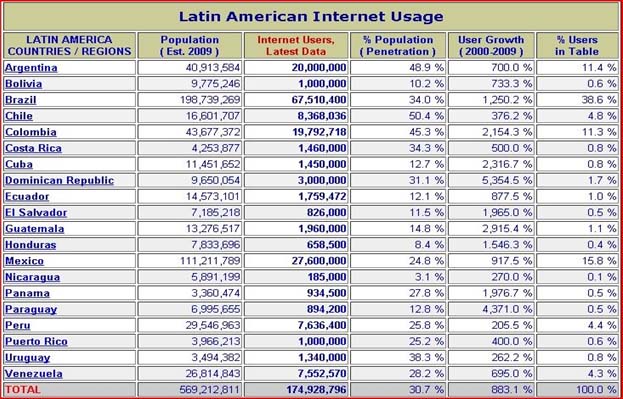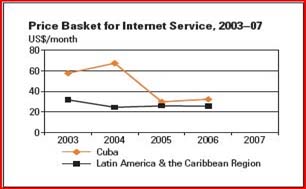|
|
|
Network Access
|
Information Infrastructure (stage 2)
Telecommunications access in Cuba is limited, the telecom infrastructure has not seen a major upgrade since 1959 prior to the Cuban revolution because of a U.S. embargo against Cuba. Cuban citizens are not able to purchase or access the internet without special authorization, foreigners can access the internet in hotels but are subject to firewall restrictions, in some cases foreigners are asked to provide their passport number prior to accessing the internet. The primary internet service provider for the approximately 12 million people of Cuba is ETECSA, which "was separated from the Ministry of Information and Telecommunication, and established as a private joint venture with Telecom Italia. However, the Ministry regulates the phone system and set rates, so one can assume there are close ties between them and ETECSA.1 The Cuban government still has tight control over internet access and what information is readily available to its citizens, "Internet access in Cuba generally exists only through government offices, libraries, colleges, a few other institutions and some workplaces."2 For Cuban citizens to access the internet they often need to pay in dollars either at a internet caf? or to an ISP, the affordability of access is severely limited by this restriction. "To achieve a sustainable market-based telecommunications system, Cuba will need extensive policy and regulatory training and technical assistance to develop a telecommunications policy and a legal and regulatory structure that would attract private investment and promote competition to expand and modernize the telecommunications infrastructure at affordable prices."3
Internet Availability (Stage 2)
Of the approximately 12 million Cubans, 1.45 million internet users exist, of which the majority of the users are accessing the internet at the workplace, universities or library. Use of the internet at home is not very prevalent, only in 2008 was a ban on personal computers lifted but internet access at home remains restricted. "The government says it is unable to connect to the giant undersea fibre-optic cables because of the US trade embargo. All online connections today are via satellite which has limited bandwidth and is expensive to use."4 The Internet Usage and Population Statistics chart shows that since 2000 internet usage has been growing, and in the past 4 years that growth has grown by almost 10%.

Among Latin American countries internet usage in Cuba is not the lowest, Cubans are situated more towards the middle of the chart then the bottom, but as compared to the rest of the world Cuba would rank towards the bottom end among countries that have high percentage of internet users.

Internet Affordability (Stage 2)
The growth of internet usage in Cuba as compared to the affordability is in direct correlation as the graph below from the World Bank indicates. The average yearly income for a Cuban is just above $3,000, so internet affordability is limited to an exclusive few who can afford it or those people working in academics or for the government or in the medical field. The general population usually gets access to the internet at an internet caf? that is government run which uses a satellite connection that is unreliable and can be slow. "The Internet in Cuba is extremely slow and expensive, and legal restrictions are among the toughest in the world. An inter-ministry commission has authority to regulate the information that comes from worldwide information webs, purportedly to ensure the country's security and defense."5 Internet affordability will remain an issue until the Cuban government loosens restrictions on access and allows fair competition for ISPs, currently providers from the US are restricted from conducting business in Cuba.

Network Speed and Quality (Stage 2)
The network infrastructure in Cuba is poor and has not seen any major upgrades since the 1959 Cuban revolution. The primary source for internet access is through a satellite connection, which is slow and unreliable, even the governments' connection to the internet is slow. "There are 3 Local Area Networks (LAN) in La Habana, and one in Matanzas and Villa Clara. Token ring architecture is used in these LANs. Modems are used for data transmission through voice grade circuits at 300, 1200 and 9600 bits per second."6 Those data rates are typically achieved over regular telephone lines, the penetration of broadband services is severely limited by trade embargos. Cuba recently agreed to a deal with Venezuela to improve its communications infrastructure, the deal would link Cuba and Venezuela via a fiber optic cable which would allow for transmission of data, video, and VoIP calls.
Hardware and Software (Stage 1)
In 2008 Cuba lifted a ban on the sale of personal computers; households are now permitted to purchase a computer, although computers are not affordable to a majority of the population. The cost of a personal computer in Cuba is $800, there is only one model available to everyone which is using relatively outdated hardware components. "Cuba ranks 111thout of 170 countries on a list that looks at personal computers per capita."7 Software distribution and coding is limited due to the lack of resources to run the software on, although since Cuba is a Spanish speaking country software is readily available for use.
Service and Support (Stage 2)
The service and support structure for communications services such as the internet is minimal, this is due to the fact that Cuban citizens must get formal approval from the government to have internet services installed at a home location. Internet usage is limited to educational institutions which are heavily monitored and government offices, there are a limited number of internet caf?'s that allow locals access. The service and support sector does not have the demand to be a viable and profitable sector in Cuba.
Recommendation
To improve Network Access in Cuba the easy solution would be to ease tensions with the US and to work on changing the government but this poses problems for the country which could potentially be a setback. The current government must develop their relations within the Latin American countries that support them, and build their Network Infrastructure from the resources that are available through their allies. Recently the Cuban government signed a deal with Venezuela which will provide the island with a high speed fiber optic connection, this link will improve the infrastructure marginally but more needs to be done to make Cuba a internet ready nation.
|
|